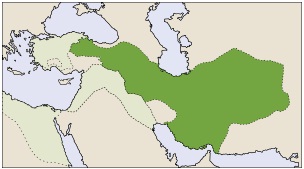

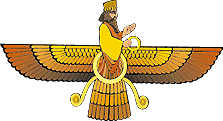
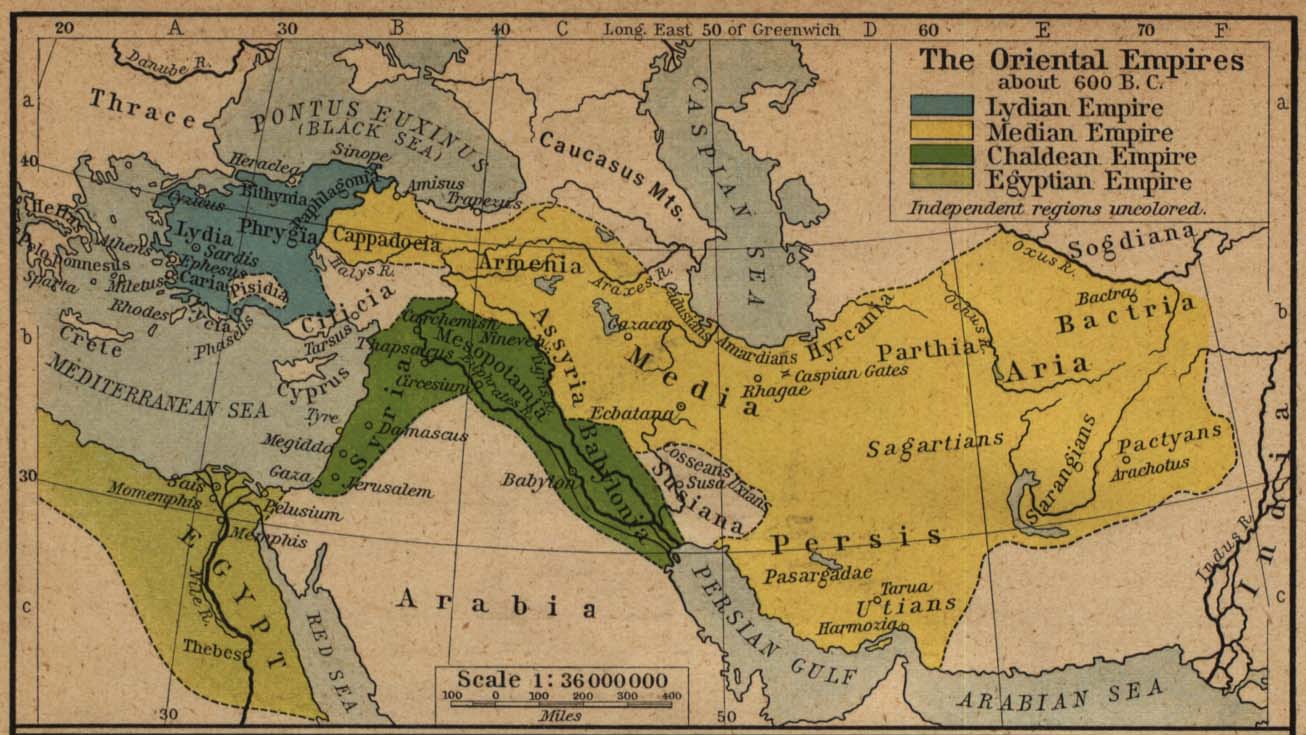
The Medes, people of the Mada (the Greek form Μῆδοι
is
Ionic
for Μᾶδοι),
appear in Assyrian record first in 836 BC. Earliest records show that
Assyrian
conqueror
Shalmaneser III
received tribute from the "Amadai" in connection with wars against the tribes of
the
Zagros.
His successors undertook many expeditions against the Medes (Madai).
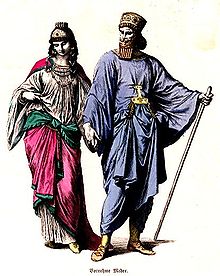
In 715 BC and 713 BC,
Sargon II of Assyria
subjected them up to "the far mountain Bikni" (Damavand
or
Alvand)
and the borders of the desert. If the account of
Herodotus
is to be trusted, the Median dynasty descends from
Deioces
(Daiukku) a prince from
Diauehi
and a Median chieftain in the
Zagros,
who, along with his kinsmen, was transported by Sargon to
Hamath
(Haniah) in
Syria
in 715 BC. This Daiukku
seems to have originally been a governor of
Mannae,
subject to Sargon prior to his exile.
In spite of repeated rebellions by the early chieftains against Assyrian rule,
the Medes paid tribute to Assyria under Sargon's successors,
Sennacherib,
Esarhaddon
and
Ashur-bani-pal
whenever these kings marched against them. Assyrian forts located in Median
territory at the time of Esarhaddon's campaign (ca. 676) included
Bit-Parnakki,
Bit-kari
and
Harhar
(Kar-Sharrukin). n't correct because all of lands uses after "Mada" are located
in mountains and plateau.
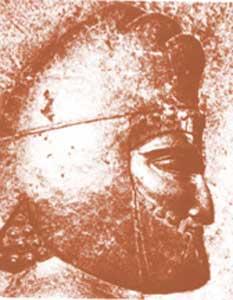
Cyaxares
or Hvakhshathra (Old
Persian:
Uvaxštra,
Greek
Κυαξάρης;
r. 625 - 585 BC), the son of King
Phraortes,
was the first king of
Media.
He reorganized and modernized the Median Army, then joined with King
Nabopolassar
of
Babylonia.
This alliance was formalized through the marriage of Cyaxares daughter,
Amytis
with
Nabopolassar's
son,
Nebuchadnezzar II,
the king who constructed the
Hanging Gardens of Babylon
as a present for his
Median
wife to help with her homesickness for the mountainous country of her birth.
These allies overthrew the
Assyrian Empire
and destroyed
Nineveh
in 612 BC. After this victory, the Medes conquered Northern
Mesopotamia,
Armenia
and the parts of
Asia Minor
east of the
Halys
River, which was the border established with
Lydia
after a decisive battle between
Lydia
and
Media,
the
Battle of Halys
ended with an eclipse on May 28, 585 BC.
The conflict between
Lydia
and the
Medes
was reported by
Herodotus
as follows:
"A horde of the nomad Scythians at feud with the rest withdrew and sought refuge
in the land of the Medes: and at this time the ruler of the Medes was Cyaxares
the son of Phraortes, the son of Deïokes, who at first dealt well with these
Scythians, being suppliants for his protection; and esteeming them very highly
he delivered boys to them to learn their speech and the art of shooting with the
bow. Then time went by, and the Scythians used to go out continually to the
chase and always brought back something; till once it happened that they took
nothing, and when they returned with empty hands Cyaxares (being, as he showed
on this occasion, not of an eminently good disposition) dealt with them very
harshly and used insult towards them. And they, when they had received this
treatment from Cyaxares, considering that they had suffered indignity, planned
to kill and to cut up one of the boys who were being instructed among them, and
having dressed his flesh as they had been wont to dress the wild animals, to
bear it to Cyaxares and give it to him, pretending that it was game taken in
hunting; and when they had given it, their design was to make their way as
quickly as possible to Alyattes the son of Sadyattes at Sardis. This then was
done; and Cyaxares with the guests who ate at his table tasted of that meat, and
the Scythians having so done became suppliants for the protection of Alyattes.
After this, since Alyattes would not give up the Scythians when Cyaxares
demanded them, there had arisen war between the Lydians and the Medes lasting
five years; in which years the Medes often discomfited the Lydians and the
Lydians often discomfited the Medes (and among others they fought also a battle
by night): and as they still carried on the war with equally balanced fortune,
in the sixth year a battle took place in which it happened, when the fight had
begun, that suddenly the day became night. And this change of the day Thales the
Milesian had foretold to the Ionians laying down as a limit this very year in
which the change took place. The Lydians however and the Medes, when they saw
that it had become night instead of day, ceased from their fighting and were
much more eager both of them that peace should be made between them. And they
who brought about the peace between them were Syennesis the Kilikian and
Labynetos the Babylonian: these were they who urged also the taking of the oath
by them, and they brought about an interchange of marriages; for they decided
that Alyattes should give his daughter Aryenis to Astyages the son of Cyaxares,
since without the compulsion of a strong tie agreements are apt not to hold
strongly together.
Cyaxares died ten years after the battle and was succeeded by his son,
Astyages,
who was the maternal grandfather of
Cyrus the Great
through his daughter
Mandane
of Media.
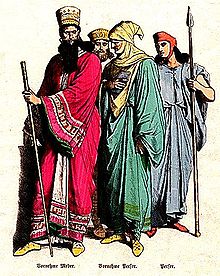
Astyages
(spelled by Herodotus
as Ἀστυάγης
- Astyages;
by Ctesias
as Astyigas; by Diodorus
as Aspadas; Akkadian:
Ištumegu; Kurdish: Azhdihak or
Ajdihak, Persian:
Persian:
ایشتوویگو
(Ištovigu)),
was the last king of
the
Median Empire, r. 585 BCE-550 BCE, the son of
Cyaxares;
he was dethroned in 550 BCE by Cyrus the Great.
His name derives from the Old Iranian Rishti Vaiga, which means "swinging
the spear, lance-hurler."
Deioces
Prince of Media-Deported
to Assyria in 715 BC
Childeren:
Cyaxares King of Media-714
BC
Cyaxares King of Media -714BC
Children:
Phraortes King of Media-675
BC
Phraortes King of Media-675
BC
Children:
Deioces
King of Media-675-646
BC
Deioces
King of Media-675-646
BC
Children:
Phraortes II King of Media-
Born
670 BC -Died (624 BC, ruled 646-624 BC Killed in battle with Assyrians)
Phraortes II King of Media-
Born 670 BC
Children:
Cyaxares (Kyaxeres) King of Media-
Born 645 BC-Died
584 BC, ruled 625-584
Cyaxares (Kyaxeres) King of Media-
Born 645 BC
Children:
Astyages King of Media
-Born
620 BC / Died
ABT 554 BC, ruled 584-554 {1}
Children:
Amytis Princess of Media -
Born
625 BC {2}
Astyages King of Media
-Born
620 BC
-
Died ABT 554 BC, ruled 584-554
{1}
Marriage:
Aryenis Princess of Lydia
died-
Married to Astyages after the battle with Lydia 28. May 585
Children:
Mandane Princess of Media
Born 595 BC – Deid ABT 554 BC (1)
Children:
Amytis II Princess of Media
Born ABT 585 BC – Deid ABT 554 BC
Mandane Princess of Media
595 BC - ABT 554 BC (1)
Marriage:
Cambyses I King of Anshan
Born
600BC – Deid ABT 554 BC
Children:
Cyrus II the Great King of Persia
Born
Ruled 559-529 BC- Died 529 BC in Afghanistan
Amytis II Princess of Media
Born ABT 585 BC – Died ABT 554 BC (2)
Marriage:
Cyrus II the Great King of Persia
Children:
Meroe Princess of Persia
Meroe Princess of Persia
Marriage:
Cambyses II King of Persia
Cyrus II the Great King of Persia
Born
Ruled 559-529 BC- Died 529 BC in Afghanistan
1. Marriage:
Neithiyti Princess of Egypt
Born
570 BC- Died ABT 530 BC
Children:
Atossa Princess of Persia
Artystone Princess of Persia
2. Marriage:
Cassandane Princess of Persia
Children:
Cambyses II King of Persia
Children:
Bardiya Prince of Persia
3. Marriage:
Amytis II Princess of Media
ABT 585 BC - ABT 554 BC
Children:
Meroe Princess of Persia
Amytis Princess of Media
-
Born
625 BC
{2}
Marriage:
Nebuchadnezzar II King of Babylon Ruled
605-562
Children
:
Eanna-shar-usur Prince of Babylon
Marduk-shum-usur Prince of Babylon
Marduk-nahin-ahhi Prince of Babylon
Mushezib Marduk Prince of Babylon
Astyages succeeded his father in 585 BCE, following the Battle of
Pteria
(Battle of Halys?), which ended a five-year war
between the Lydians
and the Medes. He inherited a large empire,
ruled in alliance with his two brothers-in-law,
Croesus of Lydia and
Nebuchadnezzar of
Babylon, whose wife, Amytis, Astyages' sister, was the queen for whom
Nebuchadnezzar was said to have built the Hanging
Gardens of Babylon.
Married to Aryenis,
the sister of King Croesus of
Lydia, to seal the treaty between the two empires, Astyages ascended to
the Median throne upon his father's death later
that year. By her he had perhaps a daughter Amytis (same as Amytis above married
to Nebuchadnezzar?) married to Cyrus the Great.
The reign of Astyages was noted for its both its stability and for the growth of
the eastern prophet-based religion, Zoroastrianism,
throughout his empire, at the same time that Croesus was patronizing notable
western philosophers (Thales,
Solon, Aesop,
etc.), and Nebuchadnezzar was busily turning his city of Babylon into the
greatest metropolis the world had yet seen.
After thirty-two years of relative stability, Astyages lost the support of his
nobles during the war to his heroic grandson Cyrus, as attested to at length in
the Cyropaeida of Xenophon, resulting in the formation of the
Persian empire, which can be considered
therefore a dynastic successor of the Medes.
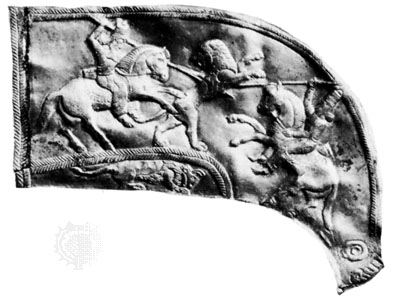
The account given by the ancient Greek
historian Herodotus relates that Astyages had a
dream in which his daughter, Mandane,
gave birth to a son who would destroy his empire. Fearful of the dream's
prophecy, Astyages married her off to Cambyses I
of
Anšan,
who had a reputation for being a "quiet and thoughtful prince" and whom Astyages
believed to be no threat.
When a second dream warned Astyages of the dangers of Mandane's offspring,
Astyages sent his general Harpagus
to kill the child, who was none other than Cyrus himself. Harpagus, unwilling to
spill royal blood, gave the infant to a shepherd, Mitridates, whose wife had
just given birth to a stillborn child. Cyrus was raised as Mitridates' own son,
and Harpagus presented the stillborn child to Astyages as the dead Cyrus.
When Cyrus was found alive at age ten, Astyages spared the boy on the advice of
his Magi, returning him to his parents in
Anshan. Harpagus, however, did not escape punishment, as Astyages is said to
have fed him his own son at a banquet.
Cyrus succeeded his father in 559, and in 553, on the advice of Harpagus, who
was eager for revenge for being given the "abominable supper," Cyrus rebelled
against Astyages. After three years of fighting, Astyages' troops mutinied
during the battle of Pasargadae,
and Cyrus conquered the Median's empire. Astyages was spared by Cyrus, and
despite being taunted by Harpagus, Herodotus says he was treated well and
remained in Cyrus' court until his death.
Rather than giving the popular mythology that Cyrus was suckled by a prostitute,
Herodotus explains that the herdsman Mitridates lived with another of Astyages'
slaves, namely a woman named 'Spaco,' which he explains is
Median for prostitute.
The contemporary Chronicle of Nabonidus
refers to the mutiny on the battlefield as the cause for Astyages' overthrow,
but does not mention Harpagus by name. However, since Harpagus was Astyages'
general at the battle of Pasargadae and his family were granted high positions
in Cyrus' empire after the war, and since Harpagus went on to become Cyrus' most
successful general, it is possible he had something to do with the mutiny
against Astyages. Cyrus then went on to pillage Astyages' capital of
Ecbatana.
Ancient sources agree that after Astyages was taken by Cyrus he was treated with
clemency, though the accounts differ. Herodotus says that Cyrus kept
his
grandfather
Astyages at his court during the remainder of his life, while according
to
Ctesias,
he was made a governor of a region of Parthia
(northeastern
Iran) and was later murdered by a
political opponent, Oebaras. The circumstances of Astyages' death are not known.
After Astyages' overthrow, Croesus marched on
Cyrus to avenge Astyages. Cyrus, with Harpagus at his side, defeated
Croesus and conquered
Lydia in 547 BCE.
Mandane of Mede (Kurd) Princess from Median Empire
The true first glance of love is unforgettable between lovers. The energy of
love is like flame of fire for until eternity. The love story between Persian
prince Cambyses and Kurdish Princess Mandane are one of those love stories to be
remembered. The marriage produced thee most Nobel and honorable human being in
the history of humanity. The Emperor is known as Cyrus the Great of Median
Empire. The Emperor are known for his wisdom and declared of human right charter
in the world for the first time.
The journey of life is full of surprises. Such was the case for young Mandane.
Born to the King of Kings, hers was a path of nobility, or so it began. As
a young child, her mother, Empress Aryenis, and her father, Emperor Astyages,
known as Ahasuerus of the Median Empire, indulged her every whim. She was
their only daughter and they loved her dearly. Many people might have
fallen victim to indolence and gluttony had they been in her place, but not
Mandane. Hers was a character that was virtuous above all else, even as a
child.
The year was 570 BC and before you begin to think these were a backward people,
let me assure you this was not the case. Mandane’s father, Emperor
Astyages, was the son of Emperor Cyaxares I, the grandson of Diyako, the great
founder of the Median Empire. Diyako was renowned in his lands for his
sense of justice. He gained the trust of his people and was an elected
leader of the Airyanem Vaejah people. He was loved by his country which
extended from the present day southern shore of the Black Sea and the Aran
Province—the modern-day Republic of Azerbaijan, north all the way to present day
Central Asia, Afghanistan and Pakistan. Theirs was a huge empire unlike
any other known at that time and unlike any other since.
Her mother, Empress Aryenis, was the daughter of King Alyattes and sister of
Prince Croesus who ruled the land of the Lydian Empire. To say that Astyages was
the King of Kings was no exaggeration, the Median Empire consisted of more than
one hundred kingdoms once, all ruled by one Emperor. His rise to power was
unexpected; as the youngest son he was an unlikely heir to the throne. But
because each of his three older brothers went off on missions from whom they
never returned, he was left to inherit leadership of the Empire.
It was in the summer that she saw Cambyses for the first time. The summer
heat forced people to seek the cooler breezes of the higher mountains which had
started blowing in from the North. Mandane had spent the last four months at the
smaller mountain palace at Alvand Mountain where she had always spent each of
her fourteen summers. Unlike the sprawling castle where she spent the
majority of her time, this mountain estate was smaller and more of a home to
her.
The palace and the castle complex were built by her great grandfather, Emperor
Diyako more with security in mind. He built the castle on higher ground and in
the strategic location called Ecbatana (meaning the place of meeting). It
is called that because it is the place where leaders of the Airyanem Vaejah
nations met to combat Assyrian aggression. The location and the availability of
resources made the place an excellent choice for the King of Kings, Diyako,
after the people elected him to stop the Assyrians.
Ecbatana, capital of the Median Empire is beautifully situated at the foot of
Mount Alvand where the Silk Road passes through. The Median dynasty ruled the
Median Empire for one and half centuries. The Neo-Assyrian Empire does not make
any reference to Ecbatana. It is possible that they never were able to penetrate
east of the Alvand mountain chain after the establishment of the Median Empire.
The royal fortress was a combination of castle, treasury, and military complex
built on a hill and encircled by seven rings of walls. Each wall topped the one
below it by the height of battlements designed to sustain a long siege. Such a
fortress on a prominence circled by seven defense rings of walls with a
formidable military force was representative of Median strongholds during the
Neo-Assyrian conflict.
The castle was the place of the King of Kings court and his residence as well.
The palace, however, was boring for Princess Mandane. She could not wait for the
summer, to get out of palace and be free for a while as a young girl.
She loved the freedom she was given in these months as she and her governess,
Magizadah, left the confines of her classroom and went on walks and picnics in
the fields. She especially loved the little lake which was just a short
half-mile walk down the hill from the castle. It was there, as she walked
with a few servants through the fields of late blooming hollyhock and toadflax
that she saw King Cyrus I’s courtiers coming up the path. Mandane was hidden
from view behind a small berm and was able to watch the procession as it passed
on the road toward the city.
Since early dawn noble guests had been arriving from all over the empire for the
annual celebrations of the establishment of Median Empire which was took place
at the time of the Zoroastrian religious festival. Many of the attendees
were kings from across the vast empire in attendance to pay tribute to Mandane’s
father and celebrate the wealth of the regions.
King Cyrus I of Anshan had property in Ecbatana because of his close
relationship with the King of Kings of the Median Empire as consultant on the
security of the nations. He was visiting at this time to escape the summer heat
in Anshan and to do his business as well. He was getting old and wanted to
introduce his son to the King of Kings as his successor in case he could no
longer rule because of ill health or death. He asked Cambyses to accompany
him on this state visit to Ecbatana.
Prince Cambyses saw a small building close to a small lake before reaching the
city. He asked his father’s permission to go with few guards to drink the water
from cold springs by the lake. He would catch up later since the guards knew the
road to the city. When they came closer to the lake they saw a beautiful young
girl with a few servants in her retinue. He asked her permission to drink water
from springs; permission was granted and he approached the girl’s company. He
saw that she was dressed with silks from China and gold of Babylon, and was
indeed the most beautiful girl he had ever seen. He said to her, “I am Prince
Cambyses, son of Cyrus of Anshan. May I have the honor to know you, young
princess?”
The girl replied politely, “I am Princes Mandane of Mede, daughter of the King
of Kings Astyages of Median Empire, and my nickname is Goli Kurdistan (“flower
of Kurdistan”). You can call me Goli. They looked at each other and fell
in love in that first glance.
Cambyses was speechless for a moment and then bowed his head as is the custom of
Airyanem Vaejah people paying respect to a woman. He said, “Goli, indeed you are
much more beautiful than the Median Goli (a Median flower) and I wish to visit
you again during our visit here.” While they were gazing at each with surprise
and delight, the governess, Magizadah, approached Mandane.
Mandane said, “Governess Magizadah, this gentleman is Prince Cambyses, son of
Cyrus of Anshan, asking permission to visit us again.
Governess Magizadah bowed her head to Prince Cambyses, son of Cyrus of Anshan,
and said, “I must get the permission of Mandane’s mother, Queen of Media, and
will let you know tomorrow.”
Prince Cambyses bowed his head and said then, “I hope to see you soon,” and he
departed with his company. Mandane was very young; she had never seen a
respectable person like him before. Indeed, that was her first love.
“Come away from there, you will be seen!” admonished Governess Magizadah.
It often seemed to Mandane that her governess was more preoccupied with
propriety than with her educational duties. Governess Magizadah was very
prim and despised any hint of what she referred to as commonness in her young
charge. Mandane was well aware of this but couldn’t help herself.
She watched as the seemingly endless line of men and horses and servants wound
up the path. At the very end came an ornate carriage which held King Cyrus
and the members of his court who were attending.
Governess Magizadah send a message to Mandane’s mother, Queen Aryenis about the
meeting of Prince Cambyses, son of Cyrus of Anshan, and Mandane by the lake
springs. She told her he wanted to return for a visit with us here. The Queen of
Media send back a message telling Governess Magizadah that they were going to
have a state dinner in honor of King Cyrus of Anshan. She would make sure
Mandane would be there to meet Prince Cambyses and his family during the state
dinner.
Mandane is one of those girls who should be remembered by humanity for her honor
and wisdom. She was brought up by Queen Aryenis and King of Kings Astyages of
the Median Empire. She was a descendent of the King of Kings Diyako; the
founder of the Median Empire. Diyako earned his honors because of his justice as
a judge even before he gained the trust of the people and was elected as a
leader of the Airyanem Vaejah people.
Her mother, Queen Aryenis, daughter of King Alyattes and sister of King Croesus
of Lydia, was very pleased to see her daughter’s happiness, particularly when
Prince Cambyses I asked to marry her within a few days of their second meeting.
Prince Cambyses I first asked his own father’s permission to marry Princess
Mandane; his father was glad to hear his request. He told Prince Cambyses I, “In
our next meeting with the King of Kings Astyages, I will ask him for his
daughter hand for you.”
There was a meeting between both families and then King Cyrus I spoke to the
King of Kings Astyages. “Oh King of Kings of the Airyanem Vaejah nations, we are
very proud to be here to renew our alliance as a relative and partner in the
service of our nations. My son, Prince Cambyses I, wants to be your servant, and
he wants you to accept him as your son. We are asking your permission to allow
Princess Mandane to marry my son. As you are aware of our Parsu peoples’ blood
relationship and our family connections, we will be honored to renew our family
ties according to our people’s customs and traditions.
Astyages was very happy to hear the request and replied to King Cyrus I, “My
friend, you and your Parsu people are the backbone of the Median Empire. I am
very glad to see them be married. It will strengthen and renew our family
connections for generations to come; they can then be a united people for their
own survival. I would like to consult my Queen and Mandane before saying yes. I
will get back to you very soon.” After consultations with his Queen and Mandane
and finding family acceptance, King of Kings Astyages called for a meeting of
the families and told King Cyrus I and his son, Prince Cambyses I, in the
present of Princess Mandane and her mother, Queen Aryenis, of his the family’s
acceptance of the marriage. They announced the engagement to the palace and
publicly. The people in the Median Empire were very happy for the coming
marriage.
The wedding of Princess Mandane was celebrated throughout the Kingdom of Anshan.
After few months Prince Cambyses I’s father, King Cyrus I, passed away and
Cambyses I become King of Anshan.
King Cambyses I of Anshan was very pleased. He was honored by the King of Kings
of the Median Empire agreeing to the marriage to his daughter. He was pleased
about his kingdom’s increased security by having Mandane Queen Consort of
Anshan. The young family was happy and planned for the future.
Queen Mandane was told the history of the families by her father. She learned
that both Madayu and Parsu were the children of Matiene, the hero of the
Airyanem Vaejah people. He told Mandane that the great grandfather of her
husband, King Cambyses I of Anshan, helped his great grandfather in the
establishment of the Median Empire. We are originally related. Respect your
husband and be a good Queen of Anshan. The father reminded her about honor,
justice, truth and good before her departure to Anshan. He said Auramazdâha
(God) will help you when you help the people of Anshan.
King Cambyses I and Queen Mandane held court at Anshan and served their people
daily. Both the King and Queen were popular among the people. The people loved
them because of their justice.
The two young people were becoming more acquainted with each other, day by day.
Their love for each other was very strong. In their private times, away from the
court, they began to learn from each other about their heritage, from what they
had heard from their families and teachers.
She became pregnant and gave birth to a son in 569 BC. They named him Cyrus
after his grand- father. The King and Queen were very happy about the
birth and reported it to the families. But after few weeks they learned that the
Median army was in Anshan.
Hamma Mirwaisi is the author of the forthcoming book, “RETURN OF THE MEDES”.
Born in Iraqi, Kurdistan, he is a US citizen; he currently resides in the United
States; is an electrical engineer by trade; and has consulted on multiple
projects in the United States, Iraq and Turkey.
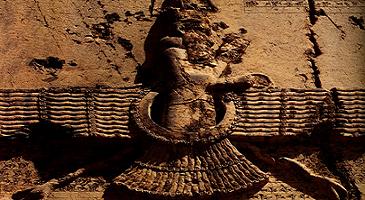
The story of Emperor Uvaxshtrahyâ (Cyaxares I) of the Median Empire
The son of Emperor Phraorte (Fravartish I), Emperor Uvaxstra or Cyaxaras [56],
became the third Emperor of the Median Empire after Emperor Ashurbanipal of
Assyrian Empire killed his father. He was also known as Hvakhshathra (Hva-kh-sha-thra),
meaning he is the Shah of Shah's. The Median Empire originated the name because,
for the first time, the Median Emperor ruled over many different nations with
different religions, each of which had its own Shah. They, however, only paid
taxes to the central government in Ecbatana.
Xasro (from the Kurdish) or Kayxosrew (Uvaxstra, 625-585 BC) is another title,
meaning, "He is better." He made the mistake initially of continuing the war
with Assyria, but he stopped when he realized he was not succeeding. During the
Assyrian war, his father's army was supported by the Scythian people under King
Madius, son of Protohyes [57]. They remained with Emperor Cyaxaras after his
father was killed, but when he stopped the war, they followed him to Ecbatana.
In Ecbatana, the Scythians seized power and took over the Median Empire, forcing
the young Emperor Cyaxares to submit to King Madius of Scythia, another branch
of the Airyanem Vaejah nations (653-625 BC). Madius declared himself King of
Kings of the Median Empire and he ruled the Empire for many years. His rule and
his army later brutalized the Median people; they treated the population badly
and in their own homeland.
The Median and Assyrian war
Emperor Cyaxares was the most brilliant politician, organizer, planner, and
religious and military leader of the Median Empire. He built many religion
temples for Anahita [60] throughout the Median Empire. He immediately
reorganized and modernized the Median army. Learning from past mistakes, his
military reputation exceeded those who preceded him. He was the first to divide
the military into separate units: archers, spearmen and cavalry. He trained his
army in military procedures and in how to command; the army learned techniques
on how to be effective in war. The military became organized as a military force
with discipline, instead of being a mob as they were before. The military was
divided into special units of warriors. Those who were to attack in front and be
ready to die for the cause were called Bears ("Hurt or Kurd") followed by Tiger
("Elam") and leopard ("Parsa").
He never favored the Median people over any other branches of the Airyanem
Vaejah people. He always said that unity among the Airyanem Vaejah nations was
the key to its survival in the presence of Semitic aggression. He even brought
back the Scythians to join him in the war against the Assyrian Empire.
He realized that war needs alliances and logistic supplies to achieve a
successful result. After all, he was preparing to attack a large empire with
much experience in war. The Assyrian Empire has been around for a long time;
they were a force not easily defeated. He was a determined leader and desired
vengeance for his father's death. He called on the Madayu relatives from Parsu,
Scythian, Parthian, and other branches from the Airyanem Vaejah nation. They
joined him because they also had been abused by the Assyrian Empire.
He realized that King Nabopolassar [61] of Babylon also hated the Assyrian
Empire even though they were both Semitic peoples, because Assyria abused every
nation in the region, even one of their own. He formalized the alliance by
having his daughter, princess Amytis (Hamy-tis, meaning "the beauty all yours"),
marry Prince Nebuchadnezzer II, son of King Nabopolassar.
The alliance attacked the Assyrian Empire from the north and south
simultaneously. They entered Nineveh, the capital, in 612 BC, three years after
my birthday; Astyages was born five years before me. The Median and Babylonian
armies rooted out all Assyrian resistance in the region.
After the defeat of the Assyrian Empire, the Babylonians added western
territories to their Empire and Media added territories east of the Halys River.
The region had peace for a time after the Assyrians were no longer a major
military force in the region.